Dissertation: Evaluating Intellectual Property Rights' Economic Impact
VerifiedAdded on 2020/07/23
|62
|24675
|59
Report
AI Summary
This report investigates the impact of Intellectual Property Rights (IPR) on economic growth and development, focusing on UK-based organizations. The study utilizes secondary data, including books, journals, and articles, to analyze how IPR, encompassing patents, trademarks, and copyrights, affects business operations and innovation. The report examines the provisions of intellectual property law, the importance of registration, and the benefits of IPR implementation. It employs a qualitative research method with thematic analysis to identify the effects of IPR on continuous economic development. The findings and recommendations highlight the role of collaborative planning and the significance of adhering to IPR policies. The report concludes with a reflective statement and references, providing a comprehensive overview of the topic for students on Desklib.
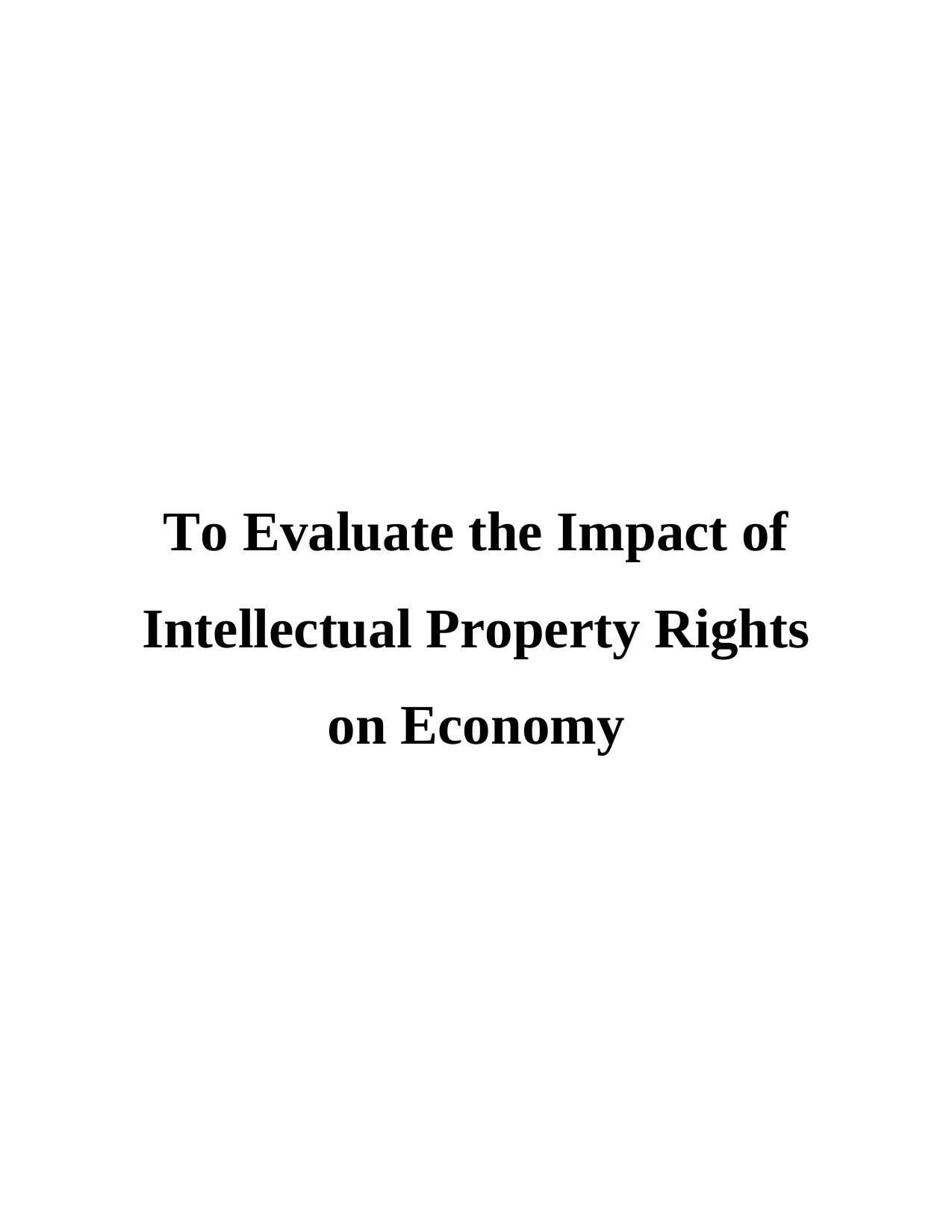
To Evaluate the Impact of
Intellectual Property Rights
on Economy
Intellectual Property Rights
on Economy
Paraphrase This Document
Need a fresh take? Get an instant paraphrase of this document with our AI Paraphraser
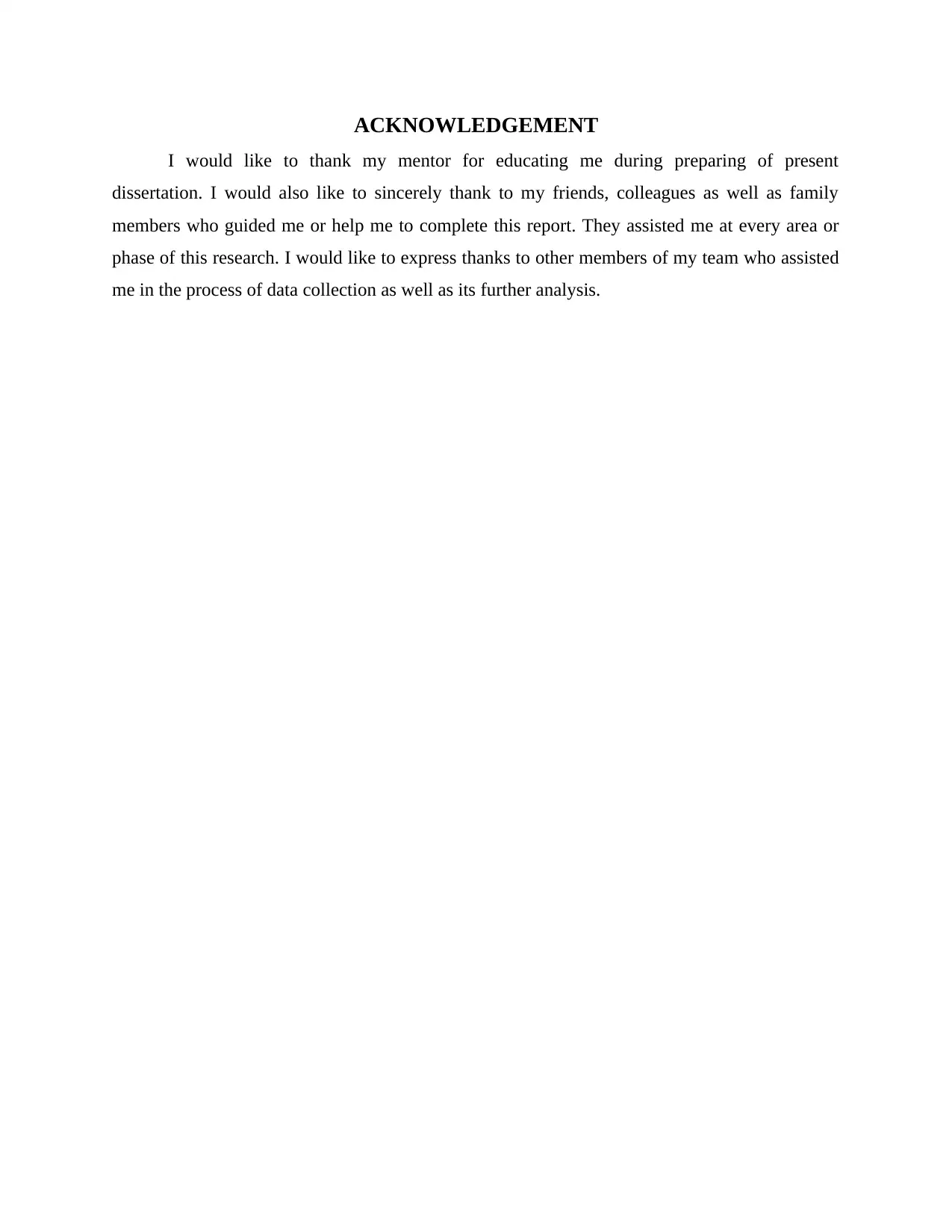
ACKNOWLEDGEMENT
I would like to thank my mentor for educating me during preparing of present
dissertation. I would also like to sincerely thank to my friends, colleagues as well as family
members who guided me or help me to complete this report. They assisted me at every area or
phase of this research. I would like to express thanks to other members of my team who assisted
me in the process of data collection as well as its further analysis.
I would like to thank my mentor for educating me during preparing of present
dissertation. I would also like to sincerely thank to my friends, colleagues as well as family
members who guided me or help me to complete this report. They assisted me at every area or
phase of this research. I would like to express thanks to other members of my team who assisted
me in the process of data collection as well as its further analysis.
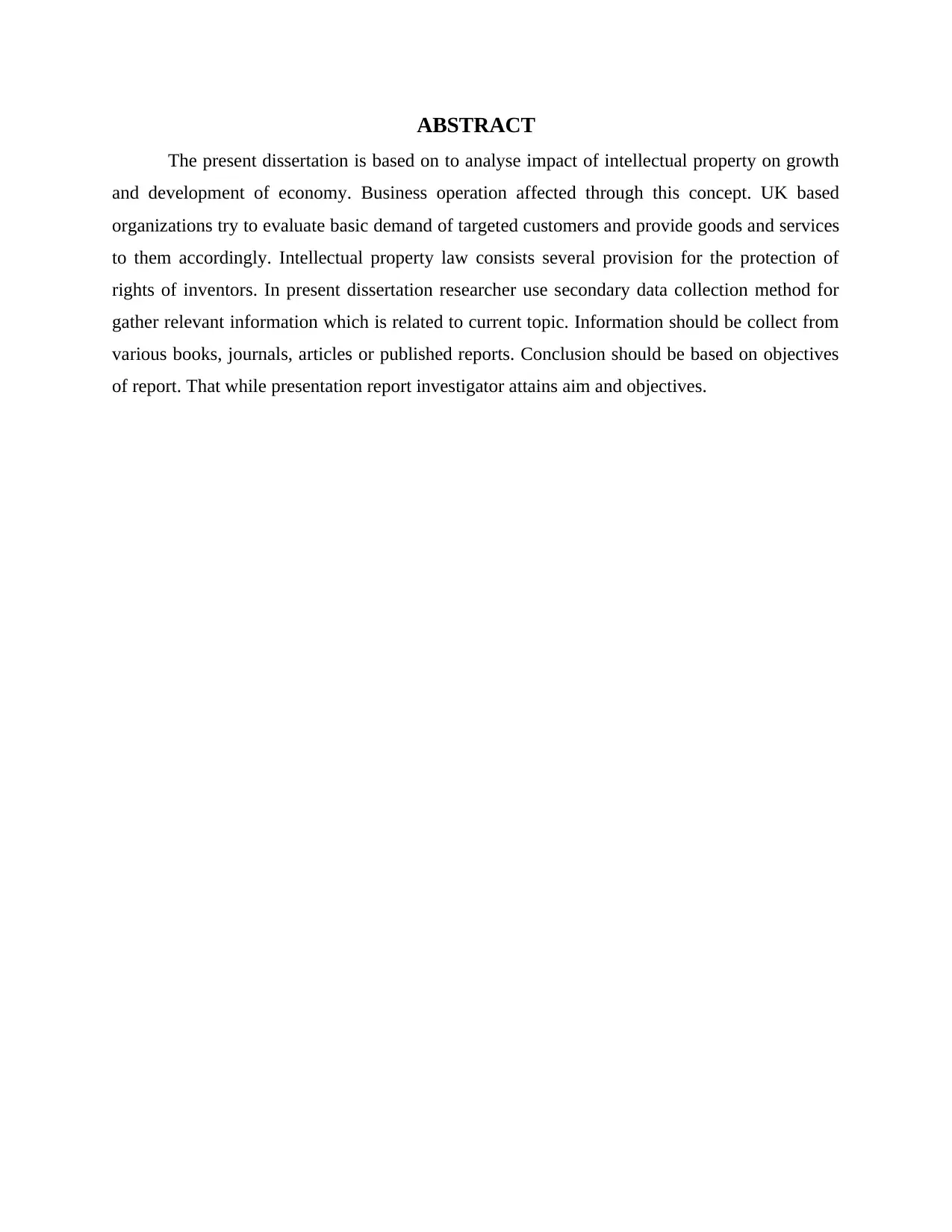
ABSTRACT
The present dissertation is based on to analyse impact of intellectual property on growth
and development of economy. Business operation affected through this concept. UK based
organizations try to evaluate basic demand of targeted customers and provide goods and services
to them accordingly. Intellectual property law consists several provision for the protection of
rights of inventors. In present dissertation researcher use secondary data collection method for
gather relevant information which is related to current topic. Information should be collect from
various books, journals, articles or published reports. Conclusion should be based on objectives
of report. That while presentation report investigator attains aim and objectives.
The present dissertation is based on to analyse impact of intellectual property on growth
and development of economy. Business operation affected through this concept. UK based
organizations try to evaluate basic demand of targeted customers and provide goods and services
to them accordingly. Intellectual property law consists several provision for the protection of
rights of inventors. In present dissertation researcher use secondary data collection method for
gather relevant information which is related to current topic. Information should be collect from
various books, journals, articles or published reports. Conclusion should be based on objectives
of report. That while presentation report investigator attains aim and objectives.
⊘ This is a preview!⊘
Do you want full access?
Subscribe today to unlock all pages.

Trusted by 1+ million students worldwide
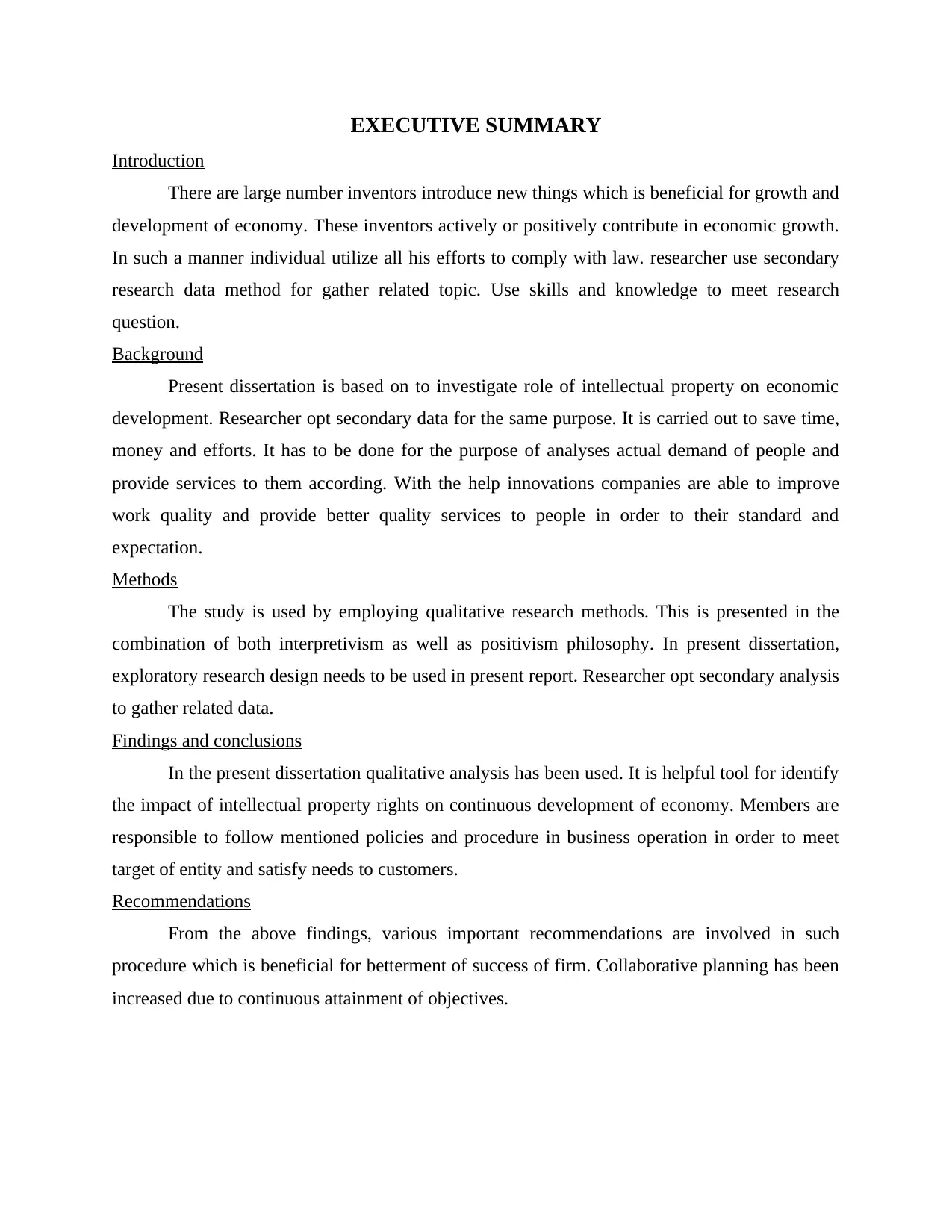
EXECUTIVE SUMMARY
Introduction
There are large number inventors introduce new things which is beneficial for growth and
development of economy. These inventors actively or positively contribute in economic growth.
In such a manner individual utilize all his efforts to comply with law. researcher use secondary
research data method for gather related topic. Use skills and knowledge to meet research
question.
Background
Present dissertation is based on to investigate role of intellectual property on economic
development. Researcher opt secondary data for the same purpose. It is carried out to save time,
money and efforts. It has to be done for the purpose of analyses actual demand of people and
provide services to them according. With the help innovations companies are able to improve
work quality and provide better quality services to people in order to their standard and
expectation.
Methods
The study is used by employing qualitative research methods. This is presented in the
combination of both interpretivism as well as positivism philosophy. In present dissertation,
exploratory research design needs to be used in present report. Researcher opt secondary analysis
to gather related data.
Findings and conclusions
In the present dissertation qualitative analysis has been used. It is helpful tool for identify
the impact of intellectual property rights on continuous development of economy. Members are
responsible to follow mentioned policies and procedure in business operation in order to meet
target of entity and satisfy needs to customers.
Recommendations
From the above findings, various important recommendations are involved in such
procedure which is beneficial for betterment of success of firm. Collaborative planning has been
increased due to continuous attainment of objectives.
Introduction
There are large number inventors introduce new things which is beneficial for growth and
development of economy. These inventors actively or positively contribute in economic growth.
In such a manner individual utilize all his efforts to comply with law. researcher use secondary
research data method for gather related topic. Use skills and knowledge to meet research
question.
Background
Present dissertation is based on to investigate role of intellectual property on economic
development. Researcher opt secondary data for the same purpose. It is carried out to save time,
money and efforts. It has to be done for the purpose of analyses actual demand of people and
provide services to them according. With the help innovations companies are able to improve
work quality and provide better quality services to people in order to their standard and
expectation.
Methods
The study is used by employing qualitative research methods. This is presented in the
combination of both interpretivism as well as positivism philosophy. In present dissertation,
exploratory research design needs to be used in present report. Researcher opt secondary analysis
to gather related data.
Findings and conclusions
In the present dissertation qualitative analysis has been used. It is helpful tool for identify
the impact of intellectual property rights on continuous development of economy. Members are
responsible to follow mentioned policies and procedure in business operation in order to meet
target of entity and satisfy needs to customers.
Recommendations
From the above findings, various important recommendations are involved in such
procedure which is beneficial for betterment of success of firm. Collaborative planning has been
increased due to continuous attainment of objectives.
Paraphrase This Document
Need a fresh take? Get an instant paraphrase of this document with our AI Paraphraser


⊘ This is a preview!⊘
Do you want full access?
Subscribe today to unlock all pages.

Trusted by 1+ million students worldwide
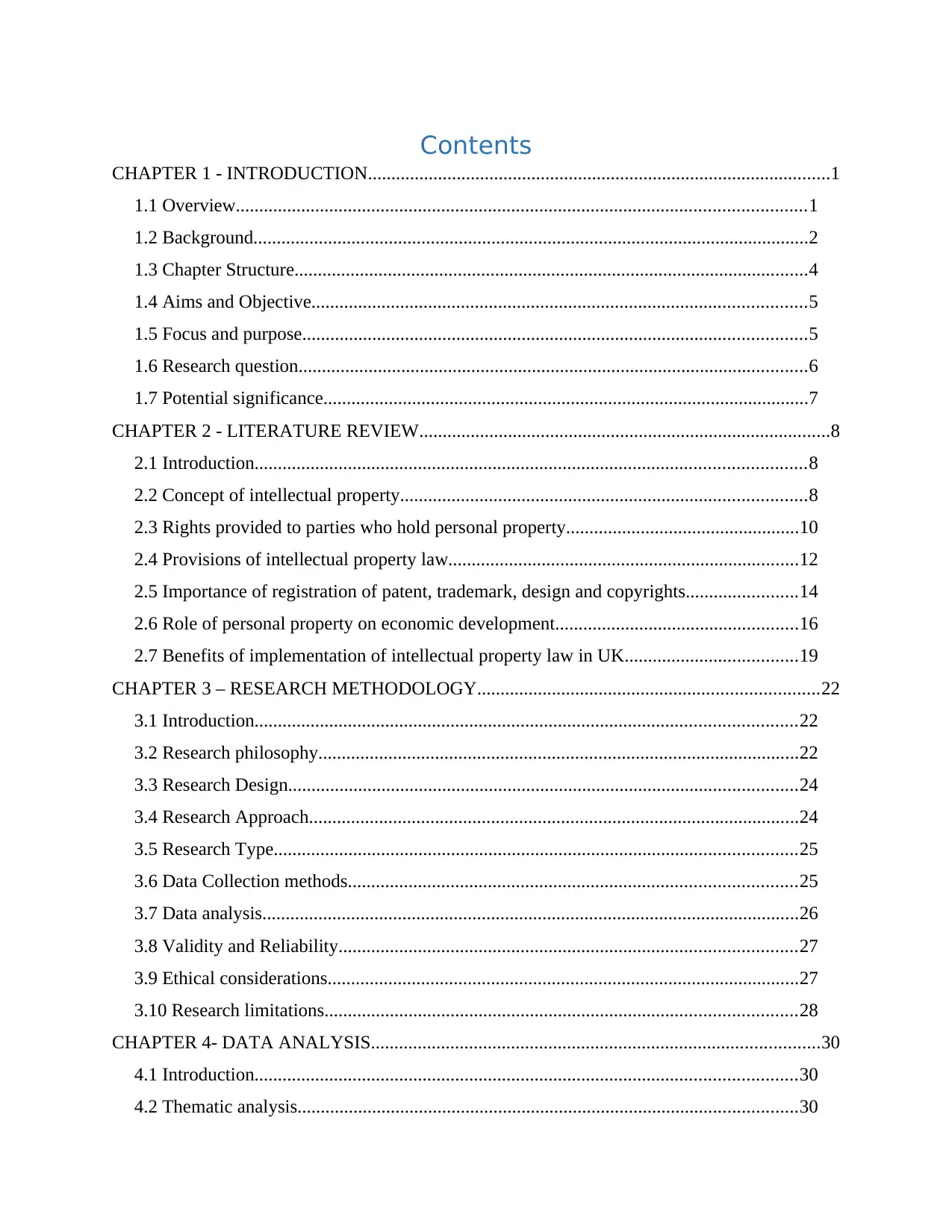
Contents
CHAPTER 1 - INTRODUCTION...................................................................................................1
1.1 Overview..........................................................................................................................1
1.2 Background.......................................................................................................................2
1.3 Chapter Structure..............................................................................................................4
1.4 Aims and Objective..........................................................................................................5
1.5 Focus and purpose............................................................................................................5
1.6 Research question.............................................................................................................6
1.7 Potential significance........................................................................................................7
CHAPTER 2 - LITERATURE REVIEW........................................................................................8
2.1 Introduction......................................................................................................................8
2.2 Concept of intellectual property.......................................................................................8
2.3 Rights provided to parties who hold personal property..................................................10
2.4 Provisions of intellectual property law...........................................................................12
2.5 Importance of registration of patent, trademark, design and copyrights........................14
2.6 Role of personal property on economic development....................................................16
2.7 Benefits of implementation of intellectual property law in UK.....................................19
CHAPTER 3 – RESEARCH METHODOLOGY.........................................................................22
3.1 Introduction....................................................................................................................22
3.2 Research philosophy.......................................................................................................22
3.3 Research Design.............................................................................................................24
3.4 Research Approach.........................................................................................................24
3.5 Research Type................................................................................................................25
3.6 Data Collection methods................................................................................................25
3.7 Data analysis...................................................................................................................26
3.8 Validity and Reliability..................................................................................................27
3.9 Ethical considerations.....................................................................................................27
3.10 Research limitations.....................................................................................................28
CHAPTER 4- DATA ANALYSIS................................................................................................30
4.1 Introduction....................................................................................................................30
4.2 Thematic analysis...........................................................................................................30
CHAPTER 1 - INTRODUCTION...................................................................................................1
1.1 Overview..........................................................................................................................1
1.2 Background.......................................................................................................................2
1.3 Chapter Structure..............................................................................................................4
1.4 Aims and Objective..........................................................................................................5
1.5 Focus and purpose............................................................................................................5
1.6 Research question.............................................................................................................6
1.7 Potential significance........................................................................................................7
CHAPTER 2 - LITERATURE REVIEW........................................................................................8
2.1 Introduction......................................................................................................................8
2.2 Concept of intellectual property.......................................................................................8
2.3 Rights provided to parties who hold personal property..................................................10
2.4 Provisions of intellectual property law...........................................................................12
2.5 Importance of registration of patent, trademark, design and copyrights........................14
2.6 Role of personal property on economic development....................................................16
2.7 Benefits of implementation of intellectual property law in UK.....................................19
CHAPTER 3 – RESEARCH METHODOLOGY.........................................................................22
3.1 Introduction....................................................................................................................22
3.2 Research philosophy.......................................................................................................22
3.3 Research Design.............................................................................................................24
3.4 Research Approach.........................................................................................................24
3.5 Research Type................................................................................................................25
3.6 Data Collection methods................................................................................................25
3.7 Data analysis...................................................................................................................26
3.8 Validity and Reliability..................................................................................................27
3.9 Ethical considerations.....................................................................................................27
3.10 Research limitations.....................................................................................................28
CHAPTER 4- DATA ANALYSIS................................................................................................30
4.1 Introduction....................................................................................................................30
4.2 Thematic analysis...........................................................................................................30
Paraphrase This Document
Need a fresh take? Get an instant paraphrase of this document with our AI Paraphraser
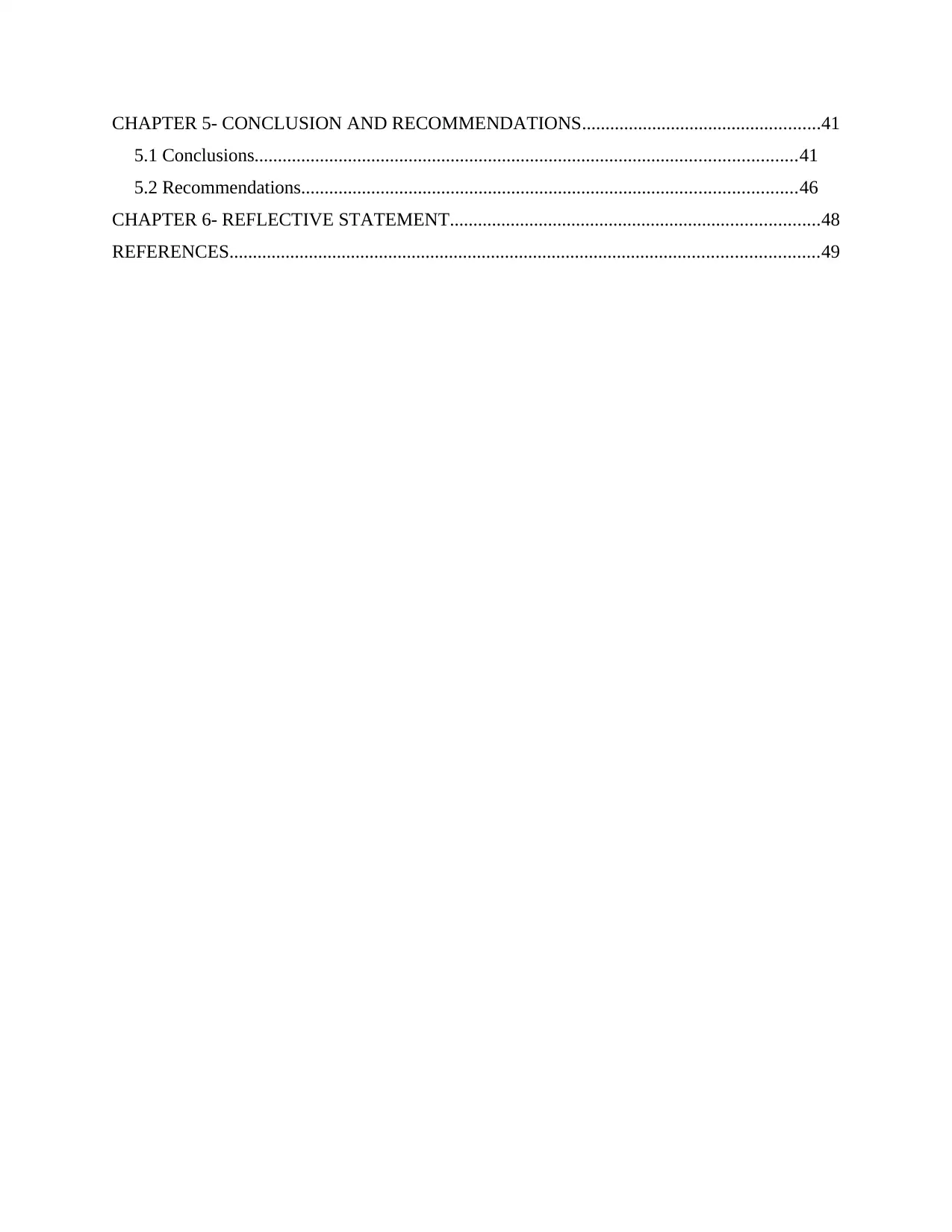
CHAPTER 5- CONCLUSION AND RECOMMENDATIONS...................................................41
5.1 Conclusions....................................................................................................................41
5.2 Recommendations..........................................................................................................46
CHAPTER 6- REFLECTIVE STATEMENT...............................................................................48
REFERENCES..............................................................................................................................49
5.1 Conclusions....................................................................................................................41
5.2 Recommendations..........................................................................................................46
CHAPTER 6- REFLECTIVE STATEMENT...............................................................................48
REFERENCES..............................................................................................................................49

⊘ This is a preview!⊘
Do you want full access?
Subscribe today to unlock all pages.

Trusted by 1+ million students worldwide
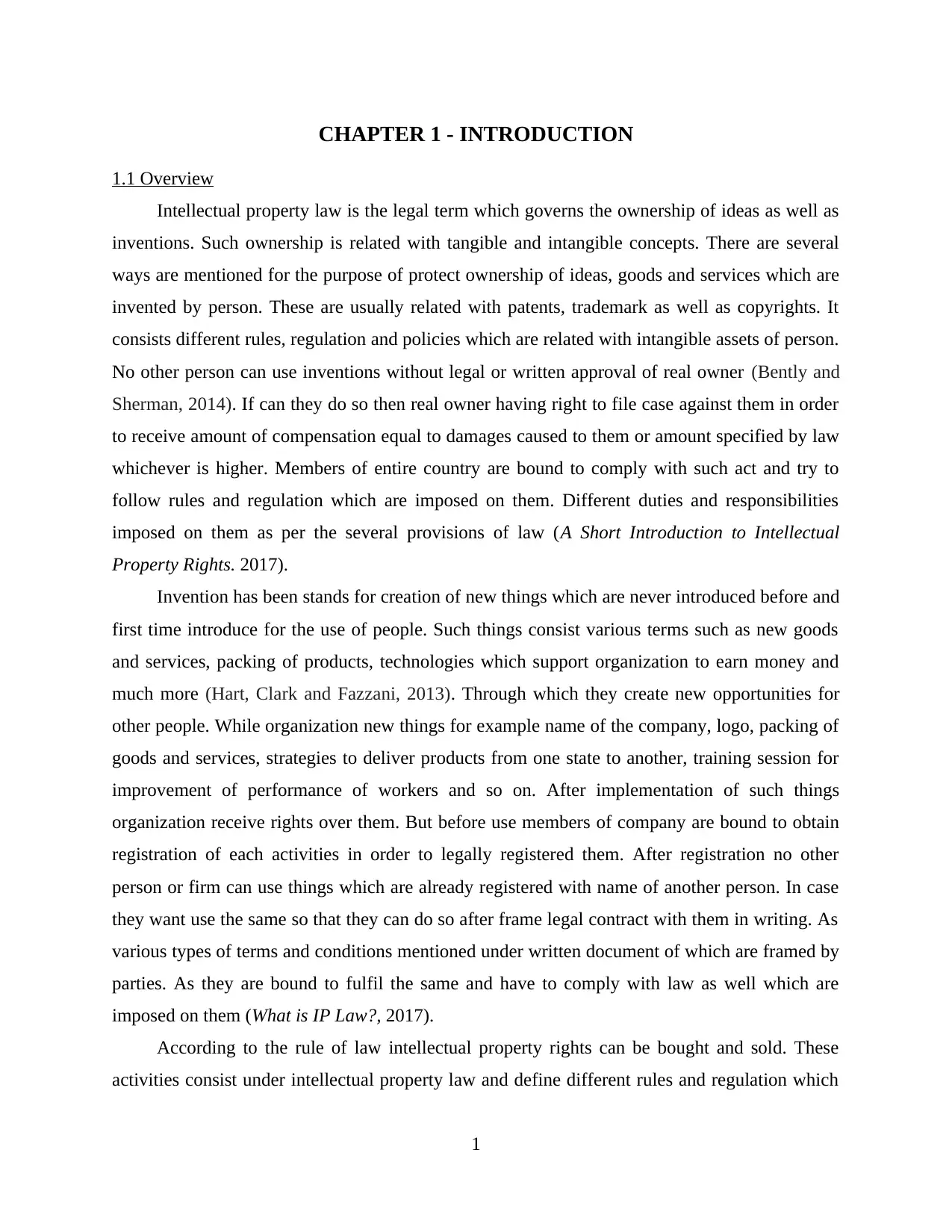
CHAPTER 1 - INTRODUCTION
1.1 Overview
Intellectual property law is the legal term which governs the ownership of ideas as well as
inventions. Such ownership is related with tangible and intangible concepts. There are several
ways are mentioned for the purpose of protect ownership of ideas, goods and services which are
invented by person. These are usually related with patents, trademark as well as copyrights. It
consists different rules, regulation and policies which are related with intangible assets of person.
No other person can use inventions without legal or written approval of real owner (Bently and
Sherman, 2014). If can they do so then real owner having right to file case against them in order
to receive amount of compensation equal to damages caused to them or amount specified by law
whichever is higher. Members of entire country are bound to comply with such act and try to
follow rules and regulation which are imposed on them. Different duties and responsibilities
imposed on them as per the several provisions of law (A Short Introduction to Intellectual
Property Rights. 2017).
Invention has been stands for creation of new things which are never introduced before and
first time introduce for the use of people. Such things consist various terms such as new goods
and services, packing of products, technologies which support organization to earn money and
much more (Hart, Clark and Fazzani, 2013). Through which they create new opportunities for
other people. While organization new things for example name of the company, logo, packing of
goods and services, strategies to deliver products from one state to another, training session for
improvement of performance of workers and so on. After implementation of such things
organization receive rights over them. But before use members of company are bound to obtain
registration of each activities in order to legally registered them. After registration no other
person or firm can use things which are already registered with name of another person. In case
they want use the same so that they can do so after frame legal contract with them in writing. As
various types of terms and conditions mentioned under written document of which are framed by
parties. As they are bound to fulfil the same and have to comply with law as well which are
imposed on them (What is IP Law?, 2017).
According to the rule of law intellectual property rights can be bought and sold. These
activities consist under intellectual property law and define different rules and regulation which
1
1.1 Overview
Intellectual property law is the legal term which governs the ownership of ideas as well as
inventions. Such ownership is related with tangible and intangible concepts. There are several
ways are mentioned for the purpose of protect ownership of ideas, goods and services which are
invented by person. These are usually related with patents, trademark as well as copyrights. It
consists different rules, regulation and policies which are related with intangible assets of person.
No other person can use inventions without legal or written approval of real owner (Bently and
Sherman, 2014). If can they do so then real owner having right to file case against them in order
to receive amount of compensation equal to damages caused to them or amount specified by law
whichever is higher. Members of entire country are bound to comply with such act and try to
follow rules and regulation which are imposed on them. Different duties and responsibilities
imposed on them as per the several provisions of law (A Short Introduction to Intellectual
Property Rights. 2017).
Invention has been stands for creation of new things which are never introduced before and
first time introduce for the use of people. Such things consist various terms such as new goods
and services, packing of products, technologies which support organization to earn money and
much more (Hart, Clark and Fazzani, 2013). Through which they create new opportunities for
other people. While organization new things for example name of the company, logo, packing of
goods and services, strategies to deliver products from one state to another, training session for
improvement of performance of workers and so on. After implementation of such things
organization receive rights over them. But before use members of company are bound to obtain
registration of each activities in order to legally registered them. After registration no other
person or firm can use things which are already registered with name of another person. In case
they want use the same so that they can do so after frame legal contract with them in writing. As
various types of terms and conditions mentioned under written document of which are framed by
parties. As they are bound to fulfil the same and have to comply with law as well which are
imposed on them (What is IP Law?, 2017).
According to the rule of law intellectual property rights can be bought and sold. These
activities consist under intellectual property law and define different rules and regulation which
1
Paraphrase This Document
Need a fresh take? Get an instant paraphrase of this document with our AI Paraphraser
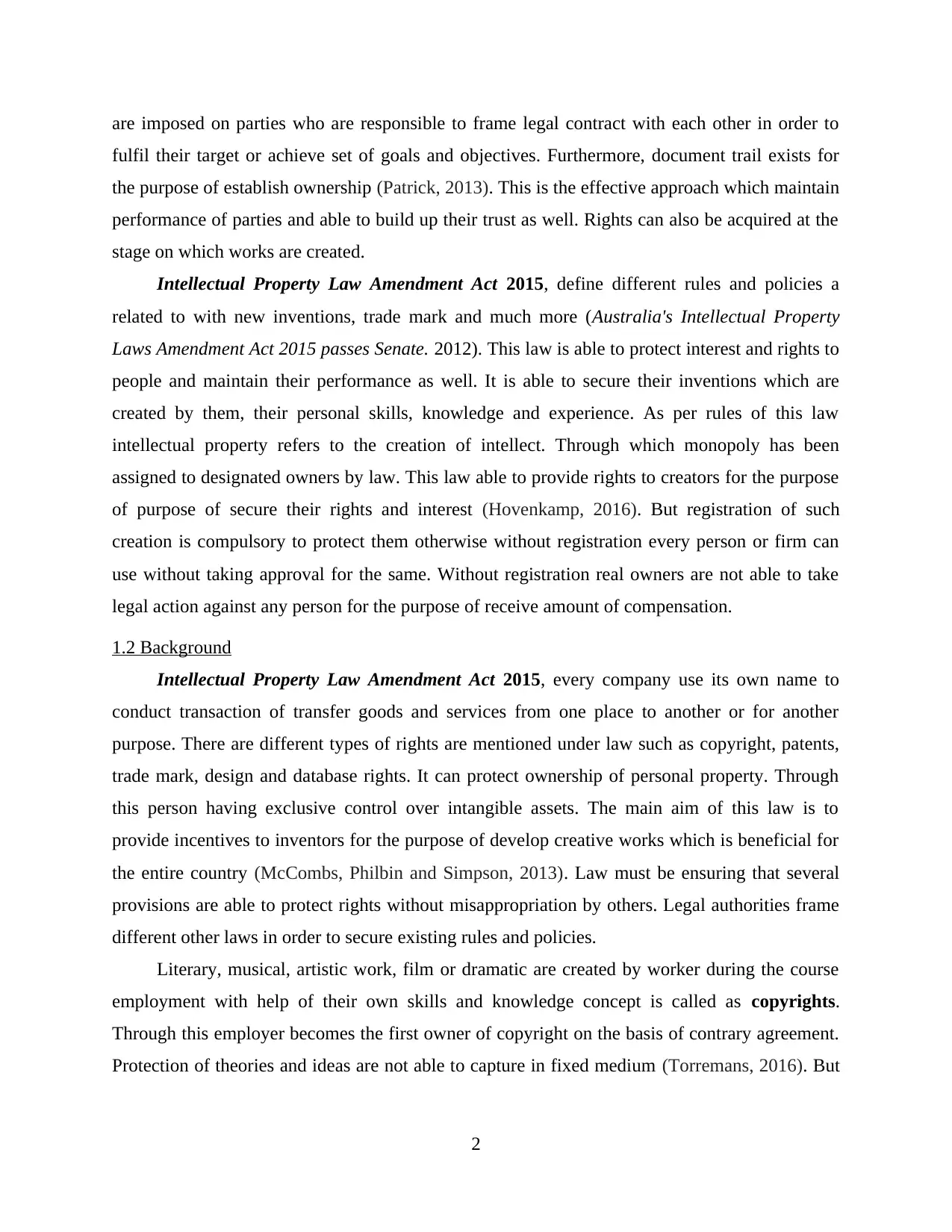
are imposed on parties who are responsible to frame legal contract with each other in order to
fulfil their target or achieve set of goals and objectives. Furthermore, document trail exists for
the purpose of establish ownership (Patrick, 2013). This is the effective approach which maintain
performance of parties and able to build up their trust as well. Rights can also be acquired at the
stage on which works are created.
Intellectual Property Law Amendment Act 2015, define different rules and policies a
related to with new inventions, trade mark and much more (Australia's Intellectual Property
Laws Amendment Act 2015 passes Senate. 2012). This law is able to protect interest and rights to
people and maintain their performance as well. It is able to secure their inventions which are
created by them, their personal skills, knowledge and experience. As per rules of this law
intellectual property refers to the creation of intellect. Through which monopoly has been
assigned to designated owners by law. This law able to provide rights to creators for the purpose
of purpose of secure their rights and interest (Hovenkamp, 2016). But registration of such
creation is compulsory to protect them otherwise without registration every person or firm can
use without taking approval for the same. Without registration real owners are not able to take
legal action against any person for the purpose of receive amount of compensation.
1.2 Background
Intellectual Property Law Amendment Act 2015, every company use its own name to
conduct transaction of transfer goods and services from one place to another or for another
purpose. There are different types of rights are mentioned under law such as copyright, patents,
trade mark, design and database rights. It can protect ownership of personal property. Through
this person having exclusive control over intangible assets. The main aim of this law is to
provide incentives to inventors for the purpose of develop creative works which is beneficial for
the entire country (McCombs, Philbin and Simpson, 2013). Law must be ensuring that several
provisions are able to protect rights without misappropriation by others. Legal authorities frame
different other laws in order to secure existing rules and policies.
Literary, musical, artistic work, film or dramatic are created by worker during the course
employment with help of their own skills and knowledge concept is called as copyrights.
Through this employer becomes the first owner of copyright on the basis of contrary agreement.
Protection of theories and ideas are not able to capture in fixed medium (Torremans, 2016). But
2
fulfil their target or achieve set of goals and objectives. Furthermore, document trail exists for
the purpose of establish ownership (Patrick, 2013). This is the effective approach which maintain
performance of parties and able to build up their trust as well. Rights can also be acquired at the
stage on which works are created.
Intellectual Property Law Amendment Act 2015, define different rules and policies a
related to with new inventions, trade mark and much more (Australia's Intellectual Property
Laws Amendment Act 2015 passes Senate. 2012). This law is able to protect interest and rights to
people and maintain their performance as well. It is able to secure their inventions which are
created by them, their personal skills, knowledge and experience. As per rules of this law
intellectual property refers to the creation of intellect. Through which monopoly has been
assigned to designated owners by law. This law able to provide rights to creators for the purpose
of purpose of secure their rights and interest (Hovenkamp, 2016). But registration of such
creation is compulsory to protect them otherwise without registration every person or firm can
use without taking approval for the same. Without registration real owners are not able to take
legal action against any person for the purpose of receive amount of compensation.
1.2 Background
Intellectual Property Law Amendment Act 2015, every company use its own name to
conduct transaction of transfer goods and services from one place to another or for another
purpose. There are different types of rights are mentioned under law such as copyright, patents,
trade mark, design and database rights. It can protect ownership of personal property. Through
this person having exclusive control over intangible assets. The main aim of this law is to
provide incentives to inventors for the purpose of develop creative works which is beneficial for
the entire country (McCombs, Philbin and Simpson, 2013). Law must be ensuring that several
provisions are able to protect rights without misappropriation by others. Legal authorities frame
different other laws in order to secure existing rules and policies.
Literary, musical, artistic work, film or dramatic are created by worker during the course
employment with help of their own skills and knowledge concept is called as copyrights.
Through this employer becomes the first owner of copyright on the basis of contrary agreement.
Protection of theories and ideas are not able to capture in fixed medium (Torremans, 2016). But
2
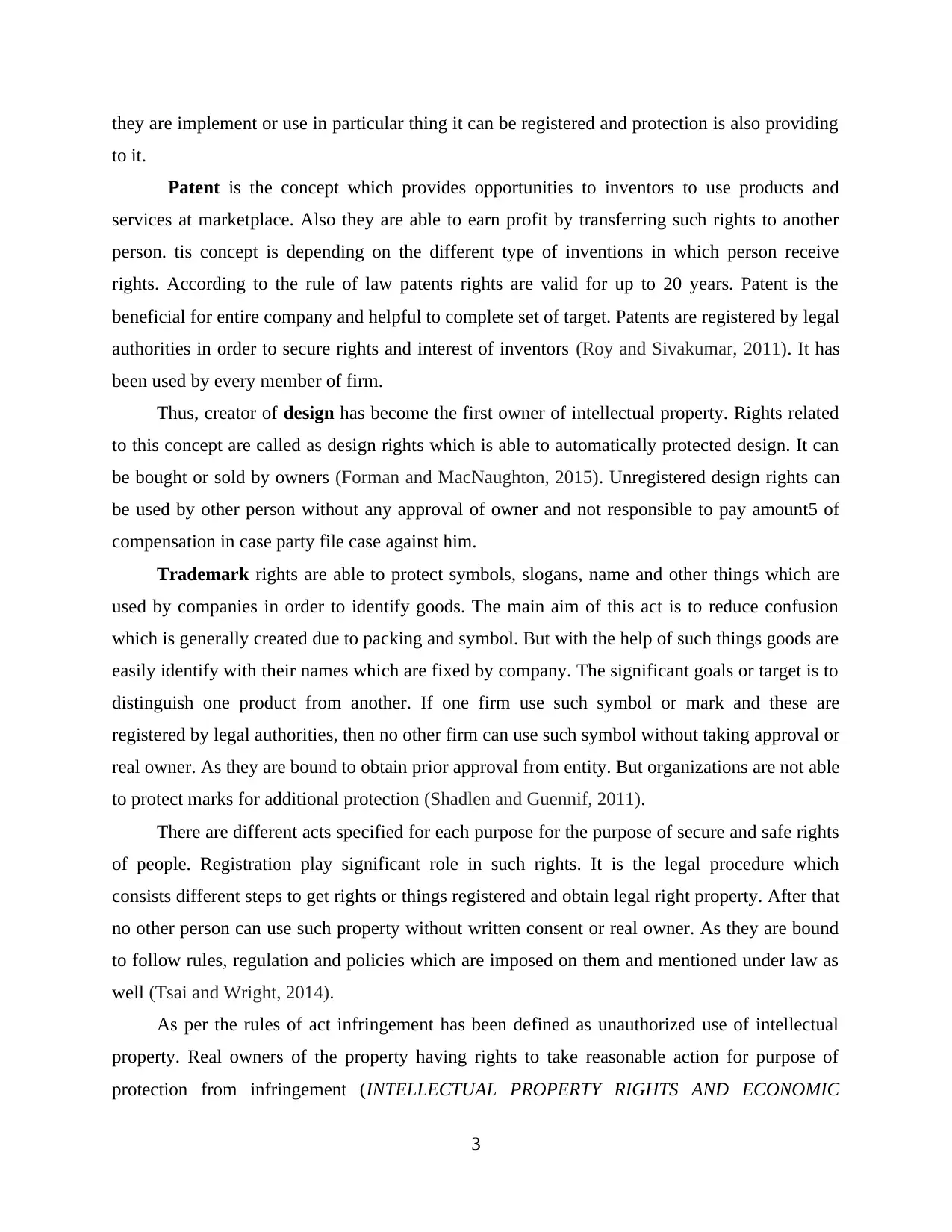
they are implement or use in particular thing it can be registered and protection is also providing
to it.
Patent is the concept which provides opportunities to inventors to use products and
services at marketplace. Also they are able to earn profit by transferring such rights to another
person. tis concept is depending on the different type of inventions in which person receive
rights. According to the rule of law patents rights are valid for up to 20 years. Patent is the
beneficial for entire company and helpful to complete set of target. Patents are registered by legal
authorities in order to secure rights and interest of inventors (Roy and Sivakumar, 2011). It has
been used by every member of firm.
Thus, creator of design has become the first owner of intellectual property. Rights related
to this concept are called as design rights which is able to automatically protected design. It can
be bought or sold by owners (Forman and MacNaughton, 2015). Unregistered design rights can
be used by other person without any approval of owner and not responsible to pay amount5 of
compensation in case party file case against him.
Trademark rights are able to protect symbols, slogans, name and other things which are
used by companies in order to identify goods. The main aim of this act is to reduce confusion
which is generally created due to packing and symbol. But with the help of such things goods are
easily identify with their names which are fixed by company. The significant goals or target is to
distinguish one product from another. If one firm use such symbol or mark and these are
registered by legal authorities, then no other firm can use such symbol without taking approval or
real owner. As they are bound to obtain prior approval from entity. But organizations are not able
to protect marks for additional protection (Shadlen and Guennif, 2011).
There are different acts specified for each purpose for the purpose of secure and safe rights
of people. Registration play significant role in such rights. It is the legal procedure which
consists different steps to get rights or things registered and obtain legal right property. After that
no other person can use such property without written consent or real owner. As they are bound
to follow rules, regulation and policies which are imposed on them and mentioned under law as
well (Tsai and Wright, 2014).
As per the rules of act infringement has been defined as unauthorized use of intellectual
property. Real owners of the property having rights to take reasonable action for purpose of
protection from infringement (INTELLECTUAL PROPERTY RIGHTS AND ECONOMIC
3
to it.
Patent is the concept which provides opportunities to inventors to use products and
services at marketplace. Also they are able to earn profit by transferring such rights to another
person. tis concept is depending on the different type of inventions in which person receive
rights. According to the rule of law patents rights are valid for up to 20 years. Patent is the
beneficial for entire company and helpful to complete set of target. Patents are registered by legal
authorities in order to secure rights and interest of inventors (Roy and Sivakumar, 2011). It has
been used by every member of firm.
Thus, creator of design has become the first owner of intellectual property. Rights related
to this concept are called as design rights which is able to automatically protected design. It can
be bought or sold by owners (Forman and MacNaughton, 2015). Unregistered design rights can
be used by other person without any approval of owner and not responsible to pay amount5 of
compensation in case party file case against him.
Trademark rights are able to protect symbols, slogans, name and other things which are
used by companies in order to identify goods. The main aim of this act is to reduce confusion
which is generally created due to packing and symbol. But with the help of such things goods are
easily identify with their names which are fixed by company. The significant goals or target is to
distinguish one product from another. If one firm use such symbol or mark and these are
registered by legal authorities, then no other firm can use such symbol without taking approval or
real owner. As they are bound to obtain prior approval from entity. But organizations are not able
to protect marks for additional protection (Shadlen and Guennif, 2011).
There are different acts specified for each purpose for the purpose of secure and safe rights
of people. Registration play significant role in such rights. It is the legal procedure which
consists different steps to get rights or things registered and obtain legal right property. After that
no other person can use such property without written consent or real owner. As they are bound
to follow rules, regulation and policies which are imposed on them and mentioned under law as
well (Tsai and Wright, 2014).
As per the rules of act infringement has been defined as unauthorized use of intellectual
property. Real owners of the property having rights to take reasonable action for purpose of
protection from infringement (INTELLECTUAL PROPERTY RIGHTS AND ECONOMIC
3
⊘ This is a preview!⊘
Do you want full access?
Subscribe today to unlock all pages.

Trusted by 1+ million students worldwide
1 out of 62
Related Documents
Your All-in-One AI-Powered Toolkit for Academic Success.
+13062052269
info@desklib.com
Available 24*7 on WhatsApp / Email
![[object Object]](/_next/static/media/star-bottom.7253800d.svg)
Unlock your academic potential
Copyright © 2020–2025 A2Z Services. All Rights Reserved. Developed and managed by ZUCOL.





